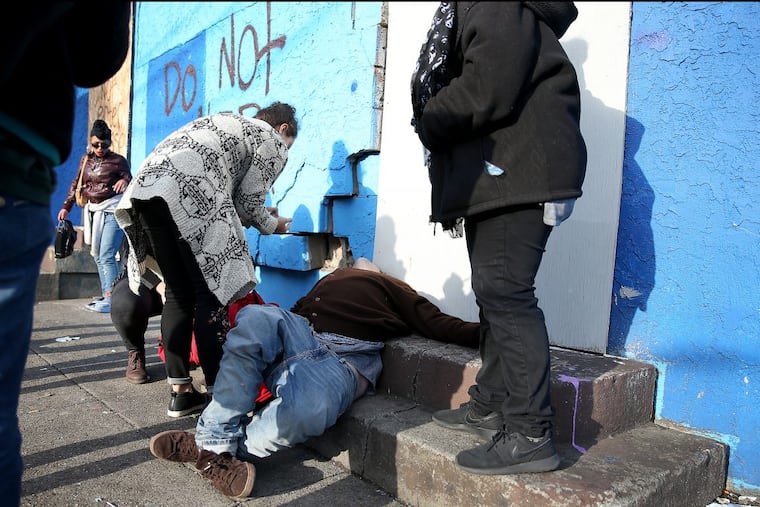On Kensington Avenue, strangers with Narcan stand between life and death | Mike Newall
I felt better when I remembered where I left the Narcan - in my glove compartment. Then, the dying man crossed in front of our car.

We were in the car on Kensington Avenue, the photographer and I, when I turned to him and said, "I don't have my Narcan."
It must have been the fifth time I said it that afternoon.
"Should we go back?" asked Dave Maialetti, whose work accompanies mine. He was worried, too.
We were a block away from our last stop – Prevention Point, the needle exchange in Kensington, the safest place on the avenue for anyone overdosing nearby.
But still, worry pulled at me. I'm never without my Narcan, the overdose-reversing spray. Not in Kensington. Not now, with ODs coming like never before. I felt naked without it, irresponsible. I've never had to use it, but I never want to be without it.
"It would happen today, wouldn't it?" I said to Dave, and that's when we saw them:
Two young men crossing Cambria with a third slumped between them. His feet dragged. His head sagged.
Dave made a U-turn and we jumped out of the car.
His companions dropped him on a step.
The man was blue, his arms splayed. One of his friends bolted. The other mashed the buttons on a corner pay phone that didn't work.
The worry that had been nagging me all day exploded. I and another passerby dialed 911 and we ran the few hundred feet to Prevention Point.
A comfort item
I've been reporting from Kensington for six months, and it became clear to me early on that I couldn't be there without Narcan. I saw the library staff at McPherson Square use it to save people, and when I left that library lawn in June I knew I needed a kit of my own if I was to continue to report here.
There are chapters in textbooks about whether reporters should get involved in their stories. In this epidemic, the journalists I know in Kensington pack Narcan.
I keep it in my back pocket. It's practically a comfort item at this point. We've seen so many paramedics tending to victims on the street – and talked to so many survivors who tell of revival after revival. I knew the moment would come when I would need it.
But we were in a rush Thursday afternoon. I could have sworn it was in my bag where I always keep it. But as we were heading to the neighborhood, I dug for it, to no avail.
Our first stop was a train bridge a short drive away where the homeless and people in addiction pitch tents along the tracks. I was worried sick when we got to the top and saw a man lying on the rails. We shook him awake. Just napping, he said.
Back in the car, on the way to Prevention Point, I felt as if I'd dodged a bullet. I felt even better when I finally remembered where I left the Narcan – in my glove compartment.
Then, the dying man crossed in front of our car.
A rush to rescue
His friend, the one that didn't run, was frantic. He didn't have Narcan either. The man on the step was dressed as if he hadn't been on the avenue long: a polka-dotted shirt and a brown cardigan. His friends had formed his jacket into a pillow. He wore a hospital bracelet.
A staff worker met me on the steps of Prevention Point. She didn't even pause when I told her what was happening. The center runs overdose drills, but reality in a city on track for 1,200 deaths this year has long ago overtaken rehearsals. On average, the rescue team saves about four people a week, said Prevention Point officials. Some weeks, they save four people a day. And their heroics prove that the deaths in Kensington are preventable — if only we would stop relying on individuals to prevent them and take collective action.
The worker shouted inside – and the rescue team, young staffers, came running with their oxygen and Narcan.
On Cambria, a crowd had formed. The man was barely breathing. The team went to work: One staffer quickly sprayed Narcan into the man's nostril, while others massaged his sternum and administered oxygen.
"He's breathing," one of the rescuers said, calmly.
By the time the ambulance arrived he was gasping awake. I checked with police the next morning. He survived.
I've felt humbled and terrible since. Humbled by the calm heroics of the rescuers — terrible about my forgetfulness. Terrible for our city, for a neighborhood, for the people trapped in an epidemic.
There are so many ways that man could have died. His friends could have taken a hit from the same batch. They could have carried him to some other corner where there isn't a team of young women who, God bless them, have become so adept at saving lives.
Life and death in Kensington hinge on luck. At least until we provide places that prevent needless deaths. Like the safe-injection sites city officials toured this week in Vancouver. Now, they must decide whether to follow suit. I pray they do.
For now, just as it was for victims on the library lawn, what stands between life and death for the young man on the step and so many like him are strangers with Narcan. I was one of the strangers Wednesday, and I didn't have Narcan. Fortunately, others did.